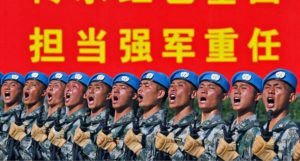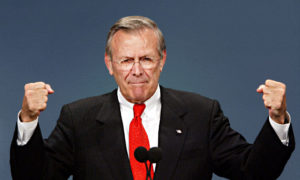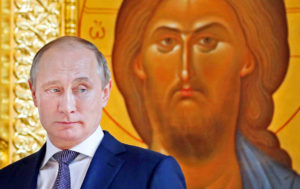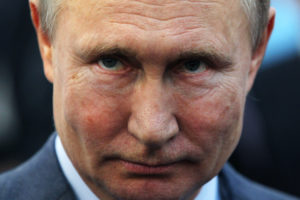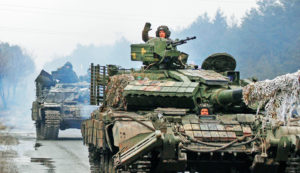When the US “Intelligence Community” of 17 different agencies started issuing imminent invasion warnings more than a month ago, I disbelieved them. There was no sign that the Russian army was stripping its bases as far away as Khabarovsk to assemble enough troops for a swift coup de main takeover of Europe’s largest country.
The original intel estimate of 127,000 troops was grossly inadequate, and when it was raised to 150,000 including forces already within the Russian-held parts of eastern Ukraine, it was still much too low for a coup de main that would start and end the war in one go — the only kind of war that Russia can fight without quickly incurring dangerous levels of economic damage.
Of course, reckless gamblers are undeterred by risks, but Putin’s record until a week ago was that of a very patient hunter, who waits until the target walks into his sights, only then pressing the trigger for a sure hit. That is how he gained Abkhazia and South Ossetia from Georgia in 2008 after inter-ethnic fighting, and broken cease-fires since 1994. Both are small but significant territories — Abkhazia because it is the southernmost, most “Mediterranean” of all Russian-controlled territories, with oranges and lemons as well as a nominally independent government, and South Ossetia because it is an Orthodox enclave in the mostly Muslim Caucasus.
And that is also how Putin won his biggest prize so far, Crimea, detaching its several pieces from Ukraine in the turmoil following the Maidan uprising that sent President Viktor Yanukovych fleeing from Kyiv on 21 February 2014: a few thousand Russian operatives with some locals took over the territory of Ukraine’s Autonomous Republic of Crimea, the autonomous city of Sevastopol, and a coastal strip in the Kherson mainland and all without firing a shot: a quickly concocted Republic of Crimea then “voted” to join the Russian Federation along with the city of Sevastopol.
To do the same thing across the 1500 kilometre width of Ukraine, it would take not less than half a million well-trained soldiers. They would need to move quickly overland to seize the cities nearest to the border such as Kharkov less than twenty miles away, or by large-airlift to reach distant Lviv, or helicoptered to simultaneously seize the regional capitals, from Lviv in the west to Kharkiv in the north-east, to Odessa in the south west, and Zaporizhia in the center-east, in addition to Kyiv, itself a metropolis of almost three million inhabitants. And yes, it all presumed only token resistance by such Ukrainian soldiers as would fight at all.
The once patient hunter turned reckless gambler persuaded himself of that, and of much more: that Ukraine’s Jewish ex-comedian turned President Zelensky would promptly flee, that his government would then collapse as ministers rushed off to escape arrest, that the Army, Navy, Air Force, and Air Defence, long starved of funds in any case would dissolve, so that Russian forces would advance unopposed to quickly seize every city, with Kyiv’s population obediently awaiting Russian rule. Then former president Yanukovych could be brought back to form a new government for the TV cameras, whose task would be to vote immediately to re-join the Russian Federation, thus ending the fighting in glorious victory for Putin and his empire.
None of the above was wildly improbable — but it hardly takes much in the way of prudence to eschew war planning that consists of stringing together best-case scenarios, which is exactly what Putin chose to do, ignoring his own Intelligence chief and veteran Kremlin official Sergey Naryshkin. That much is proven by a truly extraordinary document: the video of Putin’s eve-of-war meeting with his ministers and advisors, ostensibly on the annexation of the self-proclaimed independent Donbas republics, but actually on the imminent invasion.
We see a carefully staged display of imperial authority that has Putin sitting high up at his desk while the advisers sit in chairs below him, till each one in turn goes to stand in front of a microphone to endorse what Putin has just said. But the script fell apart when it was Naryshkin’s turn to speak. He clearly said that there should be “talks” to give the Western side a “chance”, pronouncing that French word in the French way, as Russians do. Visibly surprised, visibly angered, Putin demands an answer “yes or no” on the annexation itself, sidestepping Naryshkin’s real point: to rely on talks, not tanks in dealing with Ukraine.
The build-up to the war went well for Putin. He had the German government firmly in his camp — to the improbable extent that it went far out of its way to prevent Estonia from donating old Soviet 122mm howitzers to Ukraine, on the flimsy ground that they had briefly been in German possession when the West German army inherited East Germany’s military equipment. Nor would the German government agree to suspend the certification of the giant new Nordstream 2 gas pipeline that would have increased German dependence on Russian gas, uncaring of the vehement objections of the United States, Britain, the European Council and Poland.
Given that, Germany was bound to rule out effective sanctions in the lead-up to the fighting, with the most effective — the exclusion from the Swift payment system — not even considered, because it would block payments for Russian gas, stopping its supply. A request for weapons from the immense German surplus stocks yielded an offer of old helmets, on the grounds that German parliamentarians would prohibit the supply of lethal weapons. Providing cover for the Germans, the Italian government also ruled out a Swift cut off, and it was only Italy’s embattled Defence Minister Lorenzo Guerini’s personal determination that kept the door half-open for Italian military supplies.
Nor was the US Government much of an obstacle: instead of emulating the British airlift of anti-tank missiles on a much larger scale, the US focused on evacuating its diplomats in hysterical haste — as if to support Putin’s intimidation campaign — and then failed to airlift any of the tens of thousands of highly suitable “point and shoot” anti-tank rockets in Army depots that any civilian can use with one minute of training.
But war is the greatest contingency. As all veterans know — and that includes the present writer — until the fighting starts, no soldier knows how he will react to combat, and still less which of his comrades will fight bravely and which will keep his head down, waiting for the noise to end. And that goes for war leaders too: in 1939 the mediocre dictator Ioannis Metaxas replied to Mussolini’s verbose ultimatum with a monosyllabic ohi — “no” — inspiring victorious fighting by the hugely outgunned Greeks. And now in 2022 Zelensky’s comedic turn as a TV President, followed by a respectable showing as an actual President, set the stage for his current act as an indomitable war leader, totally uncaring of the risk to his own life as the number one target of Russian under-cover killer teams.
After refusing Biden’s ill-judged offer to evacuate him (he asked for weapons instead) Zelensky declared that he would remain in Kyiv with his entire Cabinet to lead the fight for the city. That played its own undefinable role in inspiring Ukraine’s soldiers to resist no matter what: to hold the city of Kharkiv, close enough to the Russian border to have been within artillery range from the start, to defend Zmiinyi (snake) island in front of coastal Odessa, whose 13-man garrison came under overwhelming naval bombardment after impolitely refusing to surrender, to defend Mariupol the country’s eastern harbour, whose half a million inhabitants live less than 30 miles from the Russian border (but are holding out with the Russians still 15 miles away as of this writing), and on the Kyiv approaches through which the Russian army was supposed to swiftly advance on the city and finish the war in two days if not one.
The Ukrainian army did not run away, it did not surrender, it did not abandon its weapons to walk home, and neither was it quickly outmanoeuvred by the much better-funded Russian army, which has had the fuel, ammo, and replacement parts for much more intensive training than the badly underfunded Ukrainians. It turns out that motivation beats even training: Russian armoured columns that were supposed to advance at motor speed on the highways to Kharkov and Kyiv brushing aside token resistance to quickly seize both cities, were instead forced off the road by sustained Ukrainian anti-armour fire, and then blocked again by hard fighting when they gave up on highway momentum to advance cross-country at 3mph. Day after day, Kharkov and Kyiv not only held out but were not even attacked, except by a few missiles, more terrifying than destructive.
That is when Putin’s timetable and entire war plan fell apart.
The world could close its eyes for a day and a night to allow the Russians to finish the job, so as to continue business as usual for everyone: the trucks delivering French and Italian luxury goods to the Moscow bourgeoisie along with Audi and Mercedes cars, Dutch hydroponic vegetables and much more from Frankfurt an Oder via Warsaw and Minsk; the aircraft bringing Russian skiers to Courchevel and Megève, and shoppers to London and Paris.
But when the Russian attempt failed, and the dramatic news was made by Ukraine’s heroic resistance rather than by the expected Putin victory, Western Europeans had to open their eyes, they had to look at the Russian aggression that had brought large-war to Europe for the first time since 1945.
After Italy’s Draghi spoke with Zelensky, Italy’s objection to the Swift ban suddenly gave way to approval, forcing the Germans to switch also to avoid opprobrium as the only hold-out. With that the silent opponents like Luxembourg also had to go along, and soon enough Japan also agreed to exclude the most regime-connected banks. With that the destruction of the Russian bourgeoisie’s way of life was underway in earnest: no skiing trips to France, or foreign trips anywhere outside the Russian sphere, no sending of children to expensive boarding schools in Britain or Switzerland, no new German cars, nor fresh tomatoes.
Concurrently, the spectacle of civilians, ladies of advanced years included, preparing Molotov cocktails out of beer bottles as a last resort to defend their streets, broke down the dam of Pacifist hypocrisy (“weapons only make war worse”) releasing an expanding torrent of weapons, with Germany, last seen stopping others from helping, itself offering 5,000 Stingers, aspirational anti-aircraft weapons against jets, but deadly against helicopters. Italy is sending badly needed anti-tank weapons, and others such as the British who did not wait for the fighting to begin in order to send anti-tank missiles, are sending more weapons as the US, Canada, Sweden and others are also doing, but adding a so far unique official encouragement of volunteers willing to fight for Ukraine.
Suddenly the hitherto untouchable Putin is in trouble. He promised a quick, almost effortless victory, to instead plunge into a war increasingly costly of lives (hundreds of Russians are dead by all accounts), increasingly costly for the entire Russian economy, and disastrous for its bourgeoisie. And this for a war that Russia is not winning. That Putin has invited the Ukrainian President to send envoys to cease-fire talks is itself a tremendous defeat for him: he had insisted that he could not negotiate at all with the“drug addicts and Neo-Nazis” of Zelensky’s government, but now he must negotiate, to extricate himself from the war he deliberately started, whose costs have risen phenomenally.
If talks do start, the Ukrainians can have only one demand: an immediate and total withdrawal of Russian forces to their starting positions. And if the Russians accept that inevitable demand, it seems unlikely that Putin can remain in power, not after having overruled his Intelligence chief, to deliberately start a costly war, only to lose it.
If the Russians refuse, they must revert to a very hard fight, a slow-motion drive into Kyiv that will be marked by rising casualties, as Ukrainian resistance is strengthened by the influx of better weapons and rising military competence. Then the Russians must conquer the whole of Ukraine out to Lviv and the Carpathian mountains — where the population is mostly anti-Russian, promising ever more grinding combat.
It is hard to imagine how Putin could emerge from this scenario victorious. Yes Zelensky might be reached and murdered at any time, but it seems entirely unlikely that the morale generated by the ferocious resistance he inspired would simply disappear — if anything it might well increase.
Another possibility is nuclear escalation, and Putin’s latest is indeed to talk up in his most ominous tones Russia’s forward-deployed nuclear weapons.
Unfortunately for Putin, the action is now in the hands of old ladies with Molotov cocktails, shoe salesmen with bazookas, and increasingly experienced street fighters. None of them are likely to pause this fight for fear of Russian nuclear escalation.
That leaves Putin with no way of redeeming his promise of a swiftly victorious war, no defence against the accusation of having grievously damaged Russia and humiliated its army. The spy chief Naryshkin in the Kremlin might be the one to remove Putin with the least disruption, but of course there are other Putin appointees also ready to save mother Russia.
Disclaimer
Some of the posts we share are controversial and we do not necessarily agree with them in the whole extend. Sometimes we agree with the content or part of it but we do not agree with the narration or language. Nevertheless we find them somehow interesting, valuable and/or informative or we share them, because we strongly believe in freedom of speech, free press and journalism. We strongly encourage you to have a critical approach to all the content, do your own research and analysis to build your own opinion.
We would be glad to have your feedback.
Source: UnHerd Read the original article here: https://unherd.com

